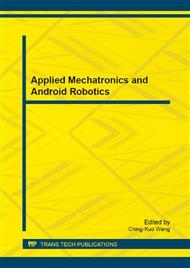[1]
M. Weck, D. Staimer, Parallel Kinematic Machine Tools – Current State and Future Potentials, CIRP Annals - Manufacturing Technology, 51 (2002) 671-683.
DOI: 10.1016/s0007-8506(07)61706-5
Google Scholar
[2]
F. Caccavale, B. Siciliano, L. Villani, The Tricept robot: Dynamics and impedance control, IEEE/ASME Transactions on Mechatronics, 8 (2003) 263-268.
DOI: 10.1109/tmech.2003.812839
Google Scholar
[3]
Y. Wang, H. Liu, T. Huang, D.G. Chetwynd, Stiffness modeling of the tricept robot using the overall jacobian matrix, Journal of Mechanisms and Robotics, 1 (2009) 1-8.
DOI: 10.1115/1.3046131
Google Scholar
[4]
S. Mingdong, J. Butterfield, The experimental test and FEA of a PKM (Exechon) in a flexible fixture application for aircraft wing assembly, in: Mechatronics and Automation (ICMA), 2011 International Conference on, 2011, pp.1225-1230.
DOI: 10.1109/icma.2011.5985836
Google Scholar
[5]
Z.M. Bi, Y. Jin, Kinematic modeling of Exechon parallel kinematic machine, Robotics and Computer-Integrated Manufacturing, 27 (2011) 186-193.
DOI: 10.1016/j.rcim.2010.07.006
Google Scholar
[6]
Y. Li, Q. Xu, Kinematic analysis of a 3-PRS parallel manipulator, Robotics and Computer-Integrated Manufacturing, 23 (2007) 395-408.
DOI: 10.1016/j.rcim.2006.04.007
Google Scholar
[7]
G. Pond, J.A. Carretero, Quantitative dexterous workspace comparison of parallel manipulators, Mechanism and Machine Theory, 42 (2007) 1388-1400.
DOI: 10.1016/j.mechmachtheory.2006.10.004
Google Scholar
[8]
M.Z. Huang, J. -L. Thebert, A study of workspace and singularity characteristics for design of 3-DOF planar parallel robots, International Journal of Advanced Manufacturing Technology, 51 (2010) 789-797.
DOI: 10.1007/s00170-010-2632-4
Google Scholar
[9]
Q. Jiang, C.M. Gosselin, Determination of the maximal singularity-free orientation workspace for the Gough–Stewart platform, Mechanism and Machine Theory, 44 (2009) 1281-1293.
DOI: 10.1016/j.mechmachtheory.2008.07.005
Google Scholar
[10]
H. Li, C.M. Gosselin, M.J. Richard, Determination of the maximal singularity-free zones in the six-dimensional workspace of the general Gough–Stewart platform, Mechanism and Machine Theory, 42 (2007) 497-511.
DOI: 10.1016/j.mechmachtheory.2006.04.006
Google Scholar
[11]
S.H. Cha, T.A. Lasky, S.A. Velinsky, Determination of the kinematically redundant active prismatic joint variable ranges of a planar parallel mechanism for singularity-free trajectories, Mechanism and Machine Theory, 44 (2009) 1032-1044.
DOI: 10.1016/j.mechmachtheory.2008.05.010
Google Scholar
[12]
A.K. Dash, I.M. Chen, S.H. Yeo, G. Yang, Workspace generation and planning singularity-free path for parallel manipulators, Mechanism and Machine Theory, 40 (2005) 776-805.
DOI: 10.1016/j.mechmachtheory.2005.01.001
Google Scholar
[13]
H. Li, C.M. Gosselin, M.J. Richard, Determination of maximal singularity-free zones in the workspace of planar three-degree-of-freedom parallel mechanisms, Mechanism and Machine Theory, 41 (2006) 1157-1167.
DOI: 10.1016/j.mechmachtheory.2005.12.003
Google Scholar
[14]
T. Kokkinis, P. Millies, Parallel robot-arm regional structure with actuational redundancy, Mechanism and Machine Theory, 26 (1991) 629-641.
DOI: 10.1016/0094-114x(91)90044-5
Google Scholar
[15]
J. Hesseleach, M.B. Helm, H. Kunzmann, Workspace Enlargement for Parallel Kinematic Machines, CIRP Annals - Manufacturing Technology, 52 (2003) 343-346.
DOI: 10.1016/s0007-8506(07)60597-6
Google Scholar
[16]
Y.H. Tsoi, S.Q. Xie, Design and control of a parallel robot for ankle rehabilitation, in: 15th International Conference on Mechatronics and Machine Vision in Practice, M2VIP'08, December 2, 2008 - December 4, 2008, Inst. of Elec. and Elec. Eng. Computer Society, Auckland, New zealand, 2008, pp.515-520.
DOI: 10.1109/mmvip.2008.4749585
Google Scholar
[17]
C. -C. Kao, T. -S. Zhan, Singularity robustness of the 3RPS parallel manipulator by using the damped-rate resolved-acceleration control, Expert Systems with Applications, 37 (2010) 5134-5144.
DOI: 10.1016/j.eswa.2009.12.081
Google Scholar
[18]
J. Hesselbach, J. Maaß, C. Bier, Singularity Prediction for Parallel Robots for Improvement of Sensor-Integrated Assembly, CIRP Annals - Manufacturing Technology, 54 (2005) 349-352.
DOI: 10.1016/s0007-8506(07)60120-6
Google Scholar
[19]
D. Zlatanov, I.A. Bonev, C.M. Gosselin, Constraint singularities of parallel mechanisms, in: Robotics and Automation, 2002. Proceedings. ICRA '02. IEEE International Conference on, 2002, pp.496-502 vol. 491.
DOI: 10.1109/robot.2002.1013408
Google Scholar


